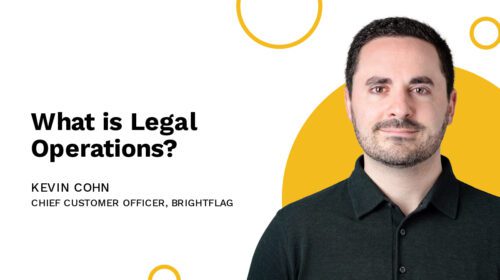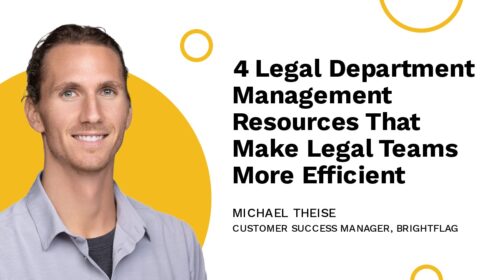How Legal Ops Can Build Their Brand on LinkedIn (And Why You Should)
As the Founder of LBH (Law But How?), I work to transform the way legal teams operate with legal design. And part of what I do is also coaching legal industry professionals on how to build a brand on LinkedIn and generate opportunities with visual content.
The mix of services I offer is the direct result of having been active on social media for four years, when I was still a head of legal in a fast-growth environment. I started my journey as a creator on LinkedIn by posting content about the things I’m nerdy about: designing better contracts that sign faster, evolving the way we think and work in-house, and exploring how visualizing legal information can provide a better user experience and improve the perception of the legal function.
A few years down the line, I quit in-house work to design my own unique path in the industry. And I owe the evolution of my career entirely to social media. My career journey was made possible as a result of having been active on LinkedIn, which helped me meet new people, connect with my first clients, and realize that new options were available to me. It has been such an eye-opening experience, and I wish this for everyone in our industry who wants to explore their options and reach their full potential.
I usually tell everyone that if they are not yet using LinkedIn as a vehicle to build their reputation online, they are missing out. For legal ops professionals, however, they can still be early to the game. In this blog post I’ll walk you through the reasons why building your legal ops voice on LinkedIn should be one of your 2023 goals, and share practical steps you can take to get going.
The Power of LinkedIn for Legal Ops Professionals
LinkedIn is the go-to platform for B2B transactions. This is where your potential audience—namely prospective clients needing legal ops support, legal executives looking for legal ops talent, and the greater in-house legal and legal ops community—spend a lot of “professional-minded” time. What I mean by that is: people go on LinkedIn in decision-making mode, open to opportunities.
This sets the platform apart. After all, people aren’t necessarily in the mood to think about legal process improvements when they scroll their Instagram feed. The fact that people are in the mood of making hiring and buying decisions, and networking with like-minded peers, puts anyone willing to grow a legal ops audience in a great position to do so on LinkedIn.
A Creator-Hungry Platform
Unlike other platforms, LinkedIn is fertile land for cultivating an audience and establishing a profile. They are clearly pushing for more creators to come and grow, and the organic reach is second-to-none. One post can get hundreds of views in a matter of hours, and up to thousands of viewers once you start growing your following.
There are very few people making the most out of the attention, let alone in the legal ops space. In fact, I can count the ones doing it effectively on my fingertips. In a nutshell: if you’re wondering how to build a brand on LinkedIn, you’re still early, and in a growing ecosystem. It’s time to get started.
Why Should You Care?
I used to work in-house before transitioning to a different career path. This was made possible thanks to social media.
Growing a social media presence means that you’re building an audience. This audience can then turn into a network, a community. People will start reaching out to you for all sorts of things. Events, podcasts, potential new jobs and clients—you name it.
You are building options. Options also mean an insurance policy against most odds.
Getting Started on LinkedIn for a Legal Ops Professional
You do not need much to get started. Here is a quick roadmap for how to build a brand on LinkedIn by taking action right away.
1. Meaningful Engagement
The in-house, legal tech, and legal innovation community on LinkedIn is growing and active. You can easily get started by simply engaging meaningfully with other creators in the space.
By meaningful engagement, I mean providing deep insights into the comment section in such a way that keeps the conversation going. Doing this exercise alone will give you three benefits:
- Getting you out of the “ghost” side of LinkedIn. The Linkedin “ghosts” are people consuming content on LinkedIn in the shadows. You have to come to the light to start becoming visible.
- Getting noticed. By standing out and upping up the game of simply ‘agreeing’ and providing additional insights, you are getting the benefits of not only being noticed by the author of the post, but also their audience who may find value in what you have to say.
- Moving the needle, from 0 to 1. LinkedIn can feel intimidating at first. Doing this exercise five minutes a day is a great way to let go of the perfectionism card and get going, building habits before taking the full leap.
2. Strategic Content
Whilst meaningful engagement is great as a starting point, doing this exercise alone won’t help you build your own audience long term. You have to create your own spotlight. And to do that you need content.
By content I mean meaningful and valuable information in relation to the one thing you want to be known for. Your niche.
This is how you can start building an audience. If you want to have people following you, they need a reason to follow. This reason is value. You provide this value with content.
Being strategic is a key aspect of ensuring you’re building your profile. It is critical to think about the things that will generate value for you. Being helpful to others is great, but keep in mind that this has to serve you. Be selfishly selfless and intentional about the things you put out.
Help others by sharing value in abundance. But do it in such a way that builds up your profile. Do not be that helpful person that talks about all sorts of things for years and wastes time (this was me for awhile).
You can be strategic by focusing on three elements
- What is it that you want to be known for: CLM, process improvements, e-billing, change management?
- Who is it that you’re targeting: in-house leaders, law firms, legal tech vendors?
- How is it that you’re helping people: consulting, product, coaching?
Once you’ve defined this, start putting content out using the format you feel most comfortable with (text posts, visuals, videos)
3. Consistency in the Making
Great things take time to materialize. Do not give up after three posts because nothing happened. No one will care about the things you post about for a while—until they eventually do. Have a long-term mindset and practice delayed gratification. You will be surprised to see what happens in the long run.
Build Your Brand
There is so much more that I could unpack here, but I hope this gives you a good starting point for how to build a brand on LinkedIn. For more information about how you can get started on social media and if visual content is something you’d want to explore, you can find me… as you probably already guessed—on LinkedIn!
Brightflag is also doing a tremendous job at highlighting legal creators on LinkedIn. Consider following them to find creators you can start engaging with today.



